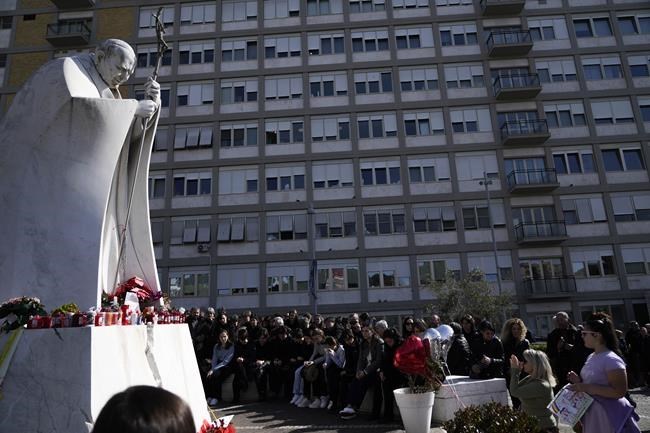
People pray outside the Agostino Gemelli Polyclinic in Rome, Sunday, Feb. 23, 2025, where Pope Francis is hospitalized since Feb. 14. (AP Photo/Gregorio Borgia)
Republished February 23, 2025 - 6:12 AM
Original Publication Date February 22, 2025 - 11:36 PM
ROME (AP) — Pope Francis was conscious but still receiving high flows of supplemental oxygen Sunday following a respiratory crisis and blood transfusions, as he remains in critical condition with a complex lung infection, the Vatican said.
“The night passed quietly, the pope rested,” Vatican spokesman Matteo Bruni said in an early statement.
Further clinical tests were being performed on the 88-year-old pope, who had part of one lung removed as a young man, and a more detailed medical update was expected later Sunday.
On Saturday, Francis suffered a prolonged asthmatic respiratory crisis that required “high flows” of oxygen to help him breathe through a nasal tube. He also received blood transfusions after tests showed low counts of platelets, which are needed for clotting, the Vatican said.
Doctors said Saturday his prognosis was “reserved.”
Doctors have said Francis’ condition is touch-and-go, given his age, fragility and pre-existing lung disease. His condition has revived speculation about what might happen if he becomes unconscious or otherwise incapacitated, and whether he might resign.
Prayers for pope at Vatican
Francis was supposed to have celebrated Mass on Sunday morning in St. Peter's Basilica and ordained deacons as part of the Vatican's yearlong Holy Year commemoration.
The organizer of the Holy Year, Archbishop Rino Fisichella, celebrated the Mass in his place and offered a special prayer for Francis from the altar before delivering the homily the pope had prepared.
“Even though he is in a hospital bed, we feel Pope Francis close to us, we feel him present among us,” Fisichella told the hundreds of white-robed deacons.
A pre-written message that Francis had prepared for his Sunday noon prayer but did not deliver said he was “confidently continuing my hospitalization at the Gemelli Hospital, carrying on with the necessary treatment; and rest is also part of the therapy!” The message noted the upcoming anniversary of Russia's invasion of Ukraine, “a painful and shameful occasion for the whole of humanity.”
The main threat facing the pope is sepsis
Doctors have warned that the main threat facing Francis would be the onset of sepsis, a serious infection of the blood that can occur as a complication of pneumonia. As of Friday, there was no evidence of any sepsis, and Francis was responding to the various drugs he is taking, the pope’s medical team said in their first in-depth update on the pope’s condition.
Saturday’s blood tests showed that he had developed a low platelet count, a condition called platelopenia or thrombocytopenia. Platelets are cell-like fragments that circulate in the blood that help form blood clots to stop bleeding or help wounds heal. Low platelet counts can be caused by a number of things, including side effects from medicines or infections, according to the U.S. National Institutes of Health.
Francis, who has chronic lung disease and is prone to bronchitis in winter, was admitted to Gemelli hospital on Feb. 14 after a weeklong bout of bronchitis worsened.
Doctors first diagnosed the complex viral, bacterial and fungal respiratory tract infection and then the onset of pneumonia in both lungs. They prescribed “absolute rest” and a combination of cortisone and antibiotics, along with supplemental oxygen when he needs it.
Francis’ recent reforms suggest he knew he was getting older and more fragile
Francis has taken several recent decisions that suggest he was well aware that he was getting old and frail.
Last year, he revised the funeral rites that will be used after he dies, simplifying the rituals to emphasize his role as a mere bishop and allowing for burial outside the Vatican in keeping with his wishes. But the core elements of the rites remain, including the three key moments that must be observed between the death of a pope and his funeral: In his home, in St. Peter’s Basilica and in the place of burial.
In December, Francis created 21 new cardinals. All but one were under age 80 and thus eligible to vote in a conclave to elect his successor. Their additions brought the overall number of voting-age cardinals to 140, well over the 120 limit set by St. John Paul II. But several of the current electors are turning 80 this year, bringing the number down.
Earlier this month, once he was already sick, Francis decided to extend the five-year term of the current dean of the College of Cardinals, Cardinal Giovanni Battista Re, 91, rather than make way for someone new. As depicted in the film “Conclave,” the dean of the College of Cardinals plays an important role in the life of the Catholic hierarchy, and is a crucial figure during the transition between one papacy and the next.
Francis also decided to extend the term of the vice-dean, Argentine Cardinal Leonardo Sandri, 81.
___
Associated Press religion coverage receives support through the AP’s collaboration with The Conversation US, with funding from Lilly Endowment Inc. The AP is solely responsible for this content.
News from © The Associated Press, 2025